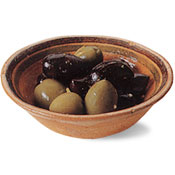|
|
Cuisine Glossary
| You have reached our International Cuisines and information on all aspects of a countries cuisine.
We will try to explain the culture, significant influences, climate, and other factors that have come together to create a distinct style. For example: Spanish, Mexican or Japanese. |
Spanish Cuisine
 |
Its history began with Phoenician, Greek, and Carthaginian coastal settlements. Later the Romans, and more importantly the Moors, brought with them elements of their own cooking that lingered and blended with Spain's culinary heritage. Imports from the New World included the tomato, potato, sweet potato, vanilla, chocolate, and many varieties of beans, zucchini, and the pepper tribe. There are olives in profusion, vineyards and citrus fruit. Spaniards are very fond of garlic; they love all types of sweet and hot peppers and their beloved jamon serrano -- cured ham. The golden spice saffron enhances many Spanish foods, paella in particular. Spain's most famous wine -- sherry, both dry and sweet -- flavors entrees and desserts. Cuisine in the Iberian Peninsula echoes the cooking of the Middle East (honey and cumin) and that of the Americas (dishes combining meat with chocolate). Yet, essentially, it is family cooking, comparatively simple to prepare and characterized by fresh ingredients. Besides meat, poultry, game, and fish entrees, there are a wealth of dishes featuring beans, rice, eggs, vegetables, and savory pies that make a meal. Tapas -- small morsels or appetizers in great variety -- play a role in meals throughout the day. Source: HungryMonster Staff Writers. |




